load capacity TOYOTA RAV4 PLUG-IN HYBRID 2023 Owners Manual
[x] Cancel search | Manufacturer: TOYOTA, Model Year: 2023, Model line: RAV4 PLUG-IN HYBRID, Model: TOYOTA RAV4 PLUG-IN HYBRID 2023Pages: 718, PDF Size: 167.55 MB
Page 136 of 718
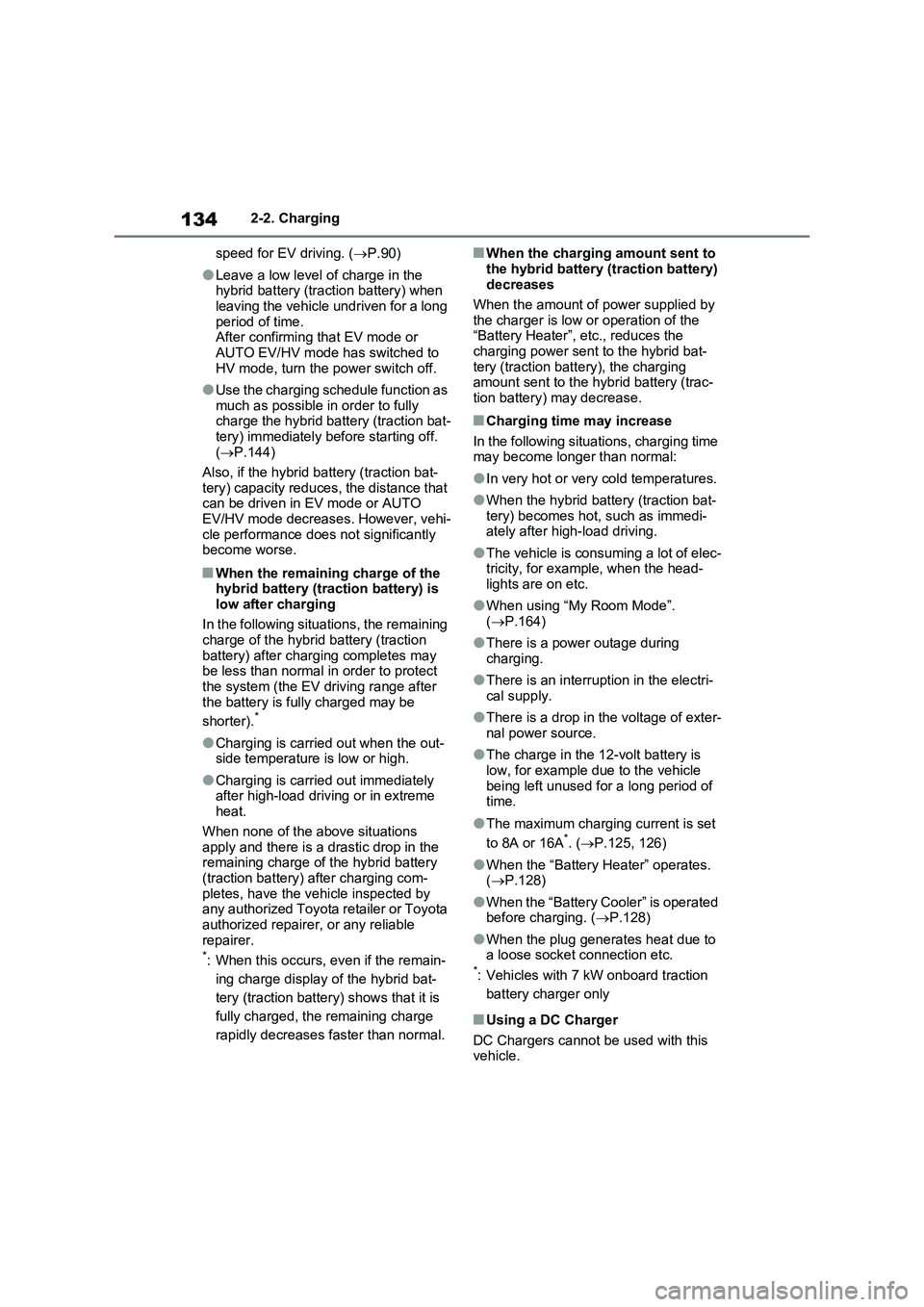
1342-2. Charging
speed for EV driving. (P.90)
●Leave a low level of charge in the
hybrid battery (traction battery) when
leaving the vehicle undriven for a long
period of time.
After confirming that EV mode or
AUTO EV/HV mode has switched to
HV mode, turn the power switch off.
●Use the charging schedule function as
much as possible in order to fully
charge the hybrid battery (traction bat-
tery) immediately before starting off.
(P.144)
Also, if the hybrid battery (traction bat-
tery) capacity reduces, the distance that
can be driven in EV mode or AUTO
EV/HV mode decreases. However, vehi-
cle performance does not significantly
become worse.
■When the remaining charge of the
hybrid battery (traction battery) is
low after charging
In the following situations, the remaining
charge of the hybrid battery (traction
battery) after charging completes may
be less than normal in order to protect
the system (the EV driving range after
the battery is fully charged may be
shorter).
*
●Charging is carried out when the out-
side temperature is low or high.
●Charging is carried out immediately
after high-load driving or in extreme
heat.
When none of the above situations
apply and there is a drastic drop in the
remaining charge of the hybrid battery
(traction battery) after charging com-
pletes, have the vehicle inspected by
any authorized Toyota retailer or Toyota
authorized repairer, or any reliable
repairer.
*: When this occurs, even if the remain-
ing charge display of the hybrid bat-
tery (traction battery) shows that it is
fully charged, the remaining charge
rapidly decreases faster than normal.
■When the charging amount sent to
the hybrid battery (traction battery)
decreases
When the amount of power supplied by
the charger is low or operation of the
“Battery Heater”, etc., reduces the
charging power sent to the hybrid bat-
tery (traction battery), the charging
amount sent to the hybrid battery (trac-
tion battery) may decrease.
■Charging time may increase
In the following situations, charging time
may become longer than normal:
●In very hot or very cold temperatures.
●When the hybrid battery (traction bat-
tery) becomes hot, such as immedi-
ately after high-load driving.
●The vehicle is consuming a lot of elec-
tricity, for example, when the head-
lights are on etc.
●When using “My Room Mode”.
(P.164)
●There is a power outage during
charging.
●There is an interruption in the electri-
cal supply.
●There is a drop in the voltage of exter-
nal power source.
●The charge in the 12-volt battery is
low, for example due to the vehicle
being left unused for a long period of
time.
●The maximum charging current is set
to 8A or 16A*. (P.125, 126)
●When the “Battery Heater” operates.
(P.128)
●When the “Battery Cooler” is operated
before charging. (P.128)
●When the plug generates heat due to
a loose socket connection etc.
*: Vehicles with 7 kW onboard traction
battery charger only
■Using a DC Charger
DC Chargers cannot be used with this
vehicle.
Page 296 of 718
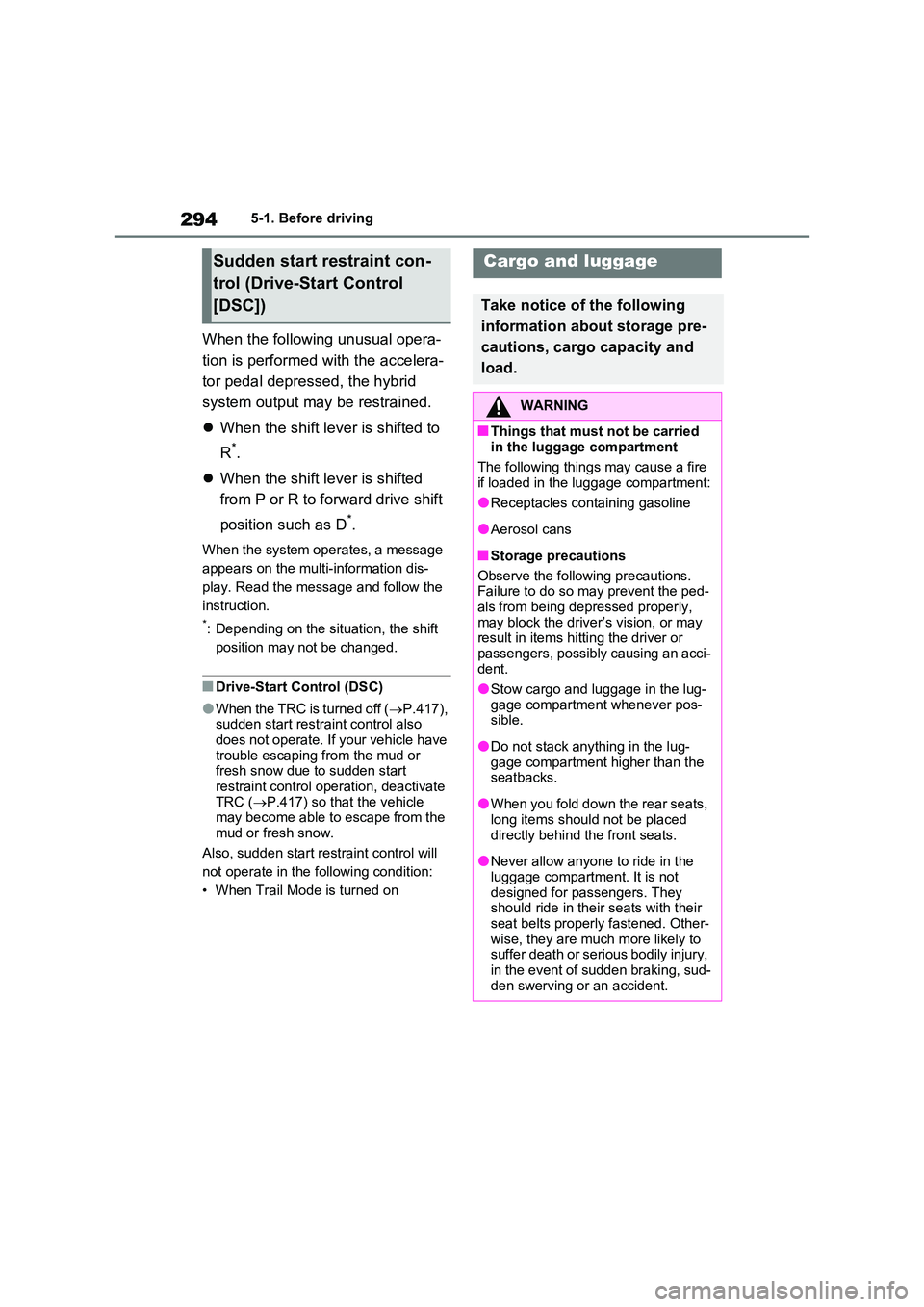
2945-1. Before driving
When the following unusual opera-
tion is performed with the accelera-
tor pedal depressed, the hybrid
system output may be restrained.
When the shift lever is shifted to
R*.
When the shift lever is shifted
from P or R to forward drive shift
position such as D*.
When the system operates, a message
appears on the multi-information dis-
play. Read the message and follow the
instruction.
*: Depending on the situation, the shift
position may not be changed.
■Drive-Start Control (DSC)
●When the TRC is turned off ( P.417), sudden start restraint control also does not operate. If your vehicle have
trouble escaping from the mud or fresh snow due to sudden start restraint control operation, deactivate
TRC ( P.417) so that the vehicle may become able to escape from the mud or fresh snow.
Also, sudden start restraint control will
not operate in the following condition:
• When Trail Mode is turned on
Sudden start restraint con-
trol (Drive-Start Control
[DSC])
Cargo and luggage
Take notice of the following
information about storage pre-
cautions, cargo capacity and
load.
WARNING
■Things that must not be carried in the luggage compartment
The following things may cause a fire if loaded in the luggage compartment:
●Receptacles containing gasoline
●Aerosol cans
■Storage precautions
Observe the following precautions. Failure to do so may prevent the ped-
als from being depressed properly, may block the driver’s vision, or may result in items hitting the driver or
passengers, possibly causing an acci- dent.
●Stow cargo and luggage in the lug-
gage compartment whenever pos- sible.
●Do not stack anything in the lug-gage compartment higher than the seatbacks.
●When you fold down the rear seats, long items should not be placed
directly behind the front seats.
●Never allow anyone to ride in the
luggage compartment. It is not designed for passengers. They should ride in their seats with their
seat belts properly fastened. Other- wise, they are much more likely to suffer death or serious bodily injury,
in the event of sudden braking, sud- den swerving or an accident.
Page 299 of 718
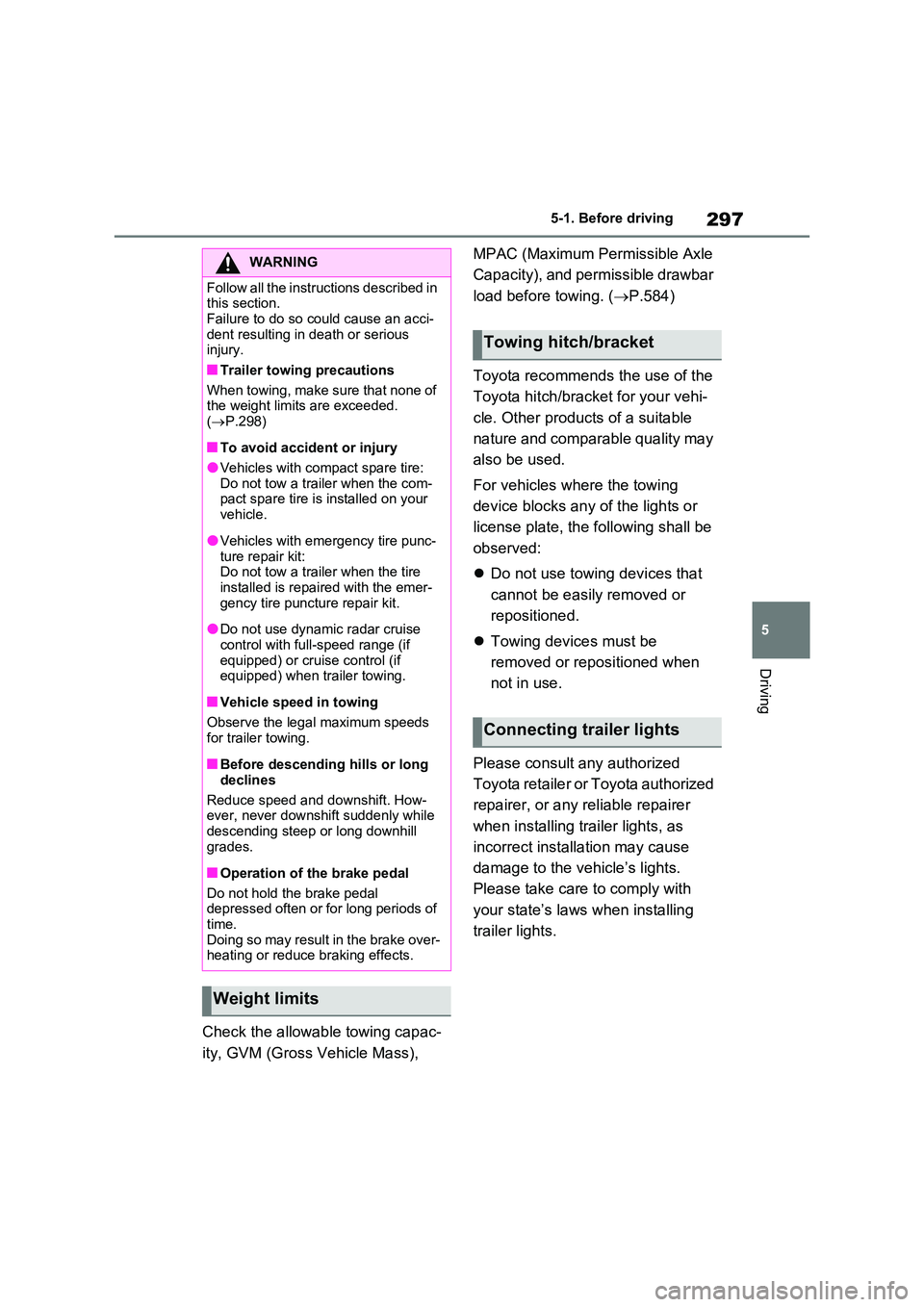
297
5
5-1. Before driving
Driving
Check the allowable towing capac-
ity, GVM (Gross Vehicle Mass),
MPAC (Maximum Permissible Axle
Capacity), and permissible drawbar
load before towing. ( P.584)
Toyota recommends the use of the
Toyota hitch/bracket for your vehi-
cle. Other products of a suitable
nature and comparable quality may
also be used.
For vehicles where the towing
device blocks any of the lights or
license plate, the following shall be
observed:
Do not use towing devices that
cannot be easily removed or
repositioned.
Towing devices must be
removed or repositioned when
not in use.
Please consult any authorized
Toyota retailer or Toyota authorized
repairer, or any reliable repairer
when installing trailer lights, as
incorrect installation may cause
damage to the vehicle’s lights.
Please take care to comply with
your state’s laws when installing
trailer lights.
WARNING
Follow all the instructions described in this section.
Failure to do so could cause an acci- dent resulting in death or serious injury.
■Trailer towing precautions
When towing, make sure that none of the weight limits are exceeded.
( P.298)
■To avoid accident or injury
●Vehicles with compact spare tire: Do not tow a trailer when the com-pact spare tire is installed on your
vehicle.
●Vehicles with emergency tire punc-
ture repair kit: Do not tow a trailer when the tire installed is repaired with the emer-
gency tire puncture repair kit.
●Do not use dynamic radar cruise
control with full-speed range (if equipped) or cruise control (if equipped) when trailer towing.
■Vehicle speed in towing
Observe the legal maximum speeds
for trailer towing.
■Before descending hills or long
declines
Reduce speed and downshift. How- ever, never downshift suddenly while
descending steep or long downhill grades.
■Operation of the brake pedal
Do not hold the brake pedal depressed often or for long periods of
time. Doing so may result in the brake over-heating or reduce braking effects.
Weight limits
Towing hitch/bracket
Connecting trailer lights
Page 300 of 718
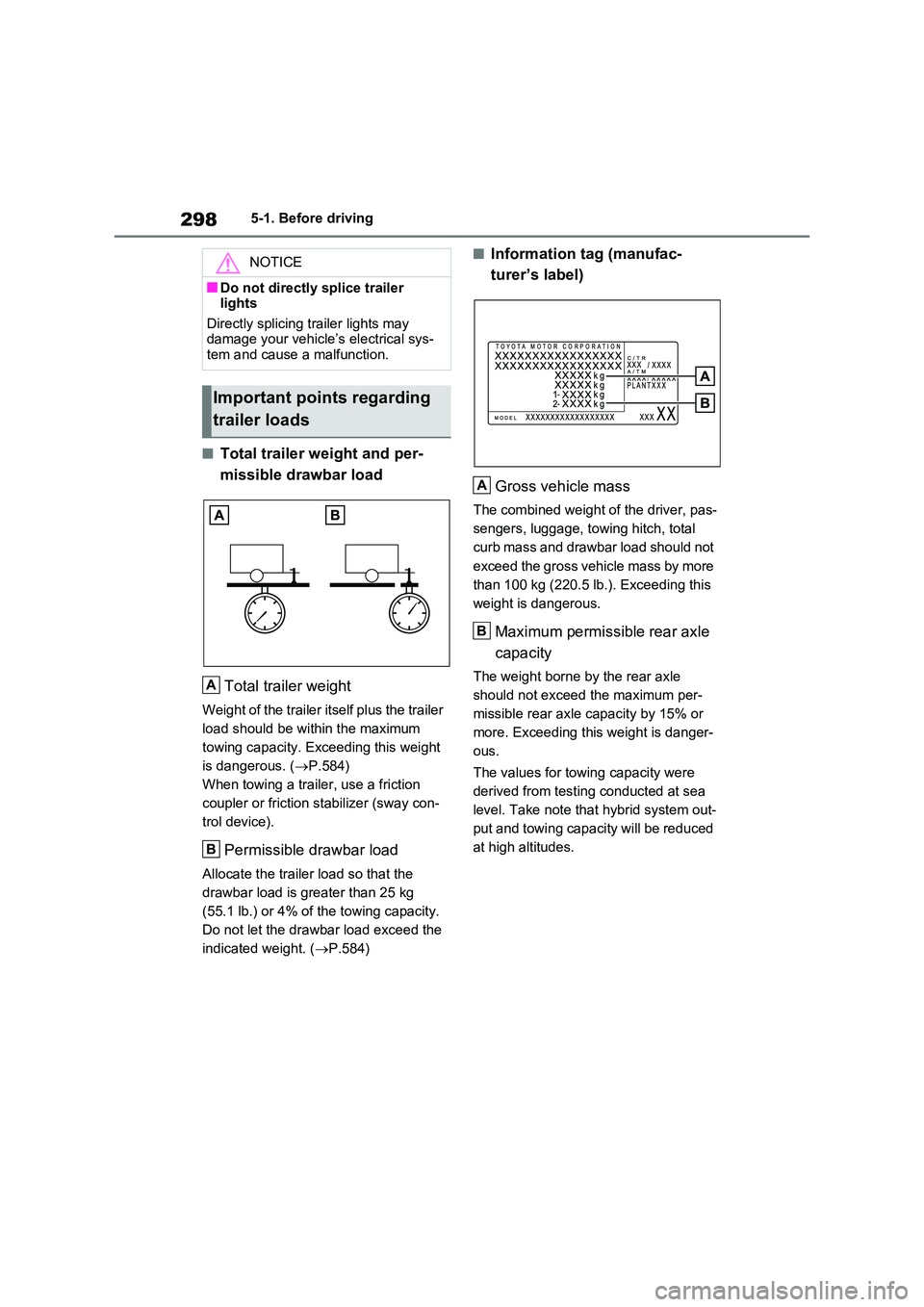
2985-1. Before driving
■Total trailer weight and per-
missible drawbar load
Total trailer weight
Weight of the trailer itself plus the trailer
load should be within the maximum
towing capacity. Exceeding this weight
is dangerous. ( P.584)
When towing a trailer, use a friction
coupler or friction stabilizer (sway con-
trol device).
Permissible drawbar load
Allocate the trailer load so that the
drawbar load is greater than 25 kg
(55.1 lb.) or 4% of the towing capacity.
Do not let the drawbar load exceed the
indicated weight. ( P.584)
■Information tag (manufac-
turer’s label)
Gross vehicle mass
The combined weight of the driver, pas-
sengers, luggage, towing hitch, total
curb mass and drawbar load should not
exceed the gross vehicle mass by more
than 100 kg (220.5 lb.). Exceeding this
weight is dangerous.
Maximum permissible rear axle
capacity
The weight borne by the rear axle
should not exceed the maximum per-
missible rear axle capacity by 15% or
more. Exceeding this weight is danger-
ous.
The values for towing capacity were
derived from testing conducted at sea
level. Take note that hybrid system out-
put and towing capacity will be reduced
at high altitudes.
NOTICE
■Do not directly splice trailer lights
Directly splicing trailer lights may damage your vehicle’s electrical sys-tem and cause a malfunction.
Important points regarding
trailer loads
A
B
A
B
Page 422 of 718
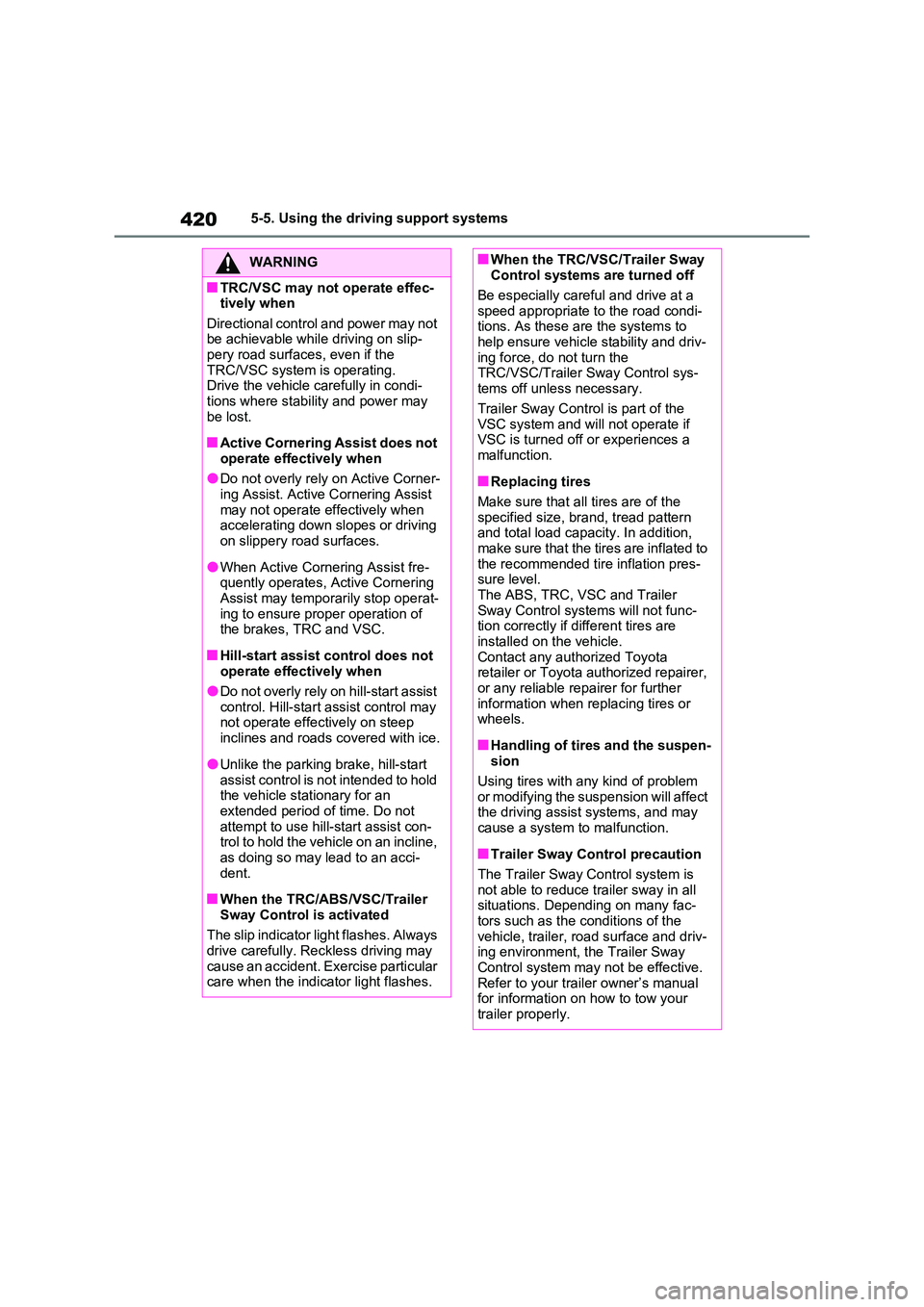
4205-5. Using the driving support systems
WARNING
■TRC/VSC may not operate effec- tively when
Directional control and power may not be achievable while driving on slip-pery road surfaces, even if the
TRC/VSC system is operating. Drive the vehicle carefully in condi-tions where stability and power may
be lost.
■Active Cornering Assist does not
operate effectively when
●Do not overly rely on Active Corner- ing Assist. Active Cornering Assist
may not operate effectively when accelerating down slopes or driving on slippery road surfaces.
●When Active Cornering Assist fre-quently operates, Active Cornering
Assist may temporarily stop operat- ing to ensure proper operation of the brakes, TRC and VSC.
■Hill-start assist control does not operate effectively when
●Do not overly rely on hill-start assist control. Hill-start assist control may not operate effectively on steep
inclines and roads covered with ice.
●Unlike the parking brake, hill-start
assist control is not intended to hold the vehicle stationary for an extended period of time. Do not
attempt to use hill-start assist con- trol to hold the vehicle on an incline, as doing so may lead to an acci-
dent.
■When the TRC/ABS/VSC/Trailer
Sway Control is activated
The slip indicator light flashes. Always drive carefully. Reckless driving may
cause an accident. Exercise particular care when the indicator light flashes.
■When the TRC/VSC/Trailer Sway Control systems are turned off
Be especially careful and drive at a
speed appropriate to the road condi- tions. As these are the systems to help ensure vehicle stability and driv-
ing force, do not turn the TRC/VSC/Trailer Sway Control sys-tems off unless necessary.
Trailer Sway Control is part of the VSC system and will not operate if VSC is turned off or experiences a
malfunction.
■Replacing tires
Make sure that all tires are of the specified size, brand, tread pattern and total load capacity. In addition,
make sure that the tires are inflated to the recommended tire inflation pres-sure level.
The ABS, TRC, VSC and Trailer Sway Control systems will not func-tion correctly if different tires are
installed on the vehicle. Contact any authorized Toyota retailer or Toyota authorized repairer,
or any reliable repairer for further information when replacing tires or wheels.
■Handling of tires and the suspen-sion
Using tires with any kind of problem or modifying the suspension will affect the driving assist systems, and may
cause a system to malfunction.
■Trailer Sway Control precaution
The Trailer Sway Control system is not able to reduce trailer sway in all situations. Depending on many fac-
tors such as the conditions of the vehicle, trailer, road surface and driv-ing environment, the Trailer Sway
Control system may not be effective. Refer to your trailer owner’s manual for information on how to tow your
trailer properly.
Page 501 of 718
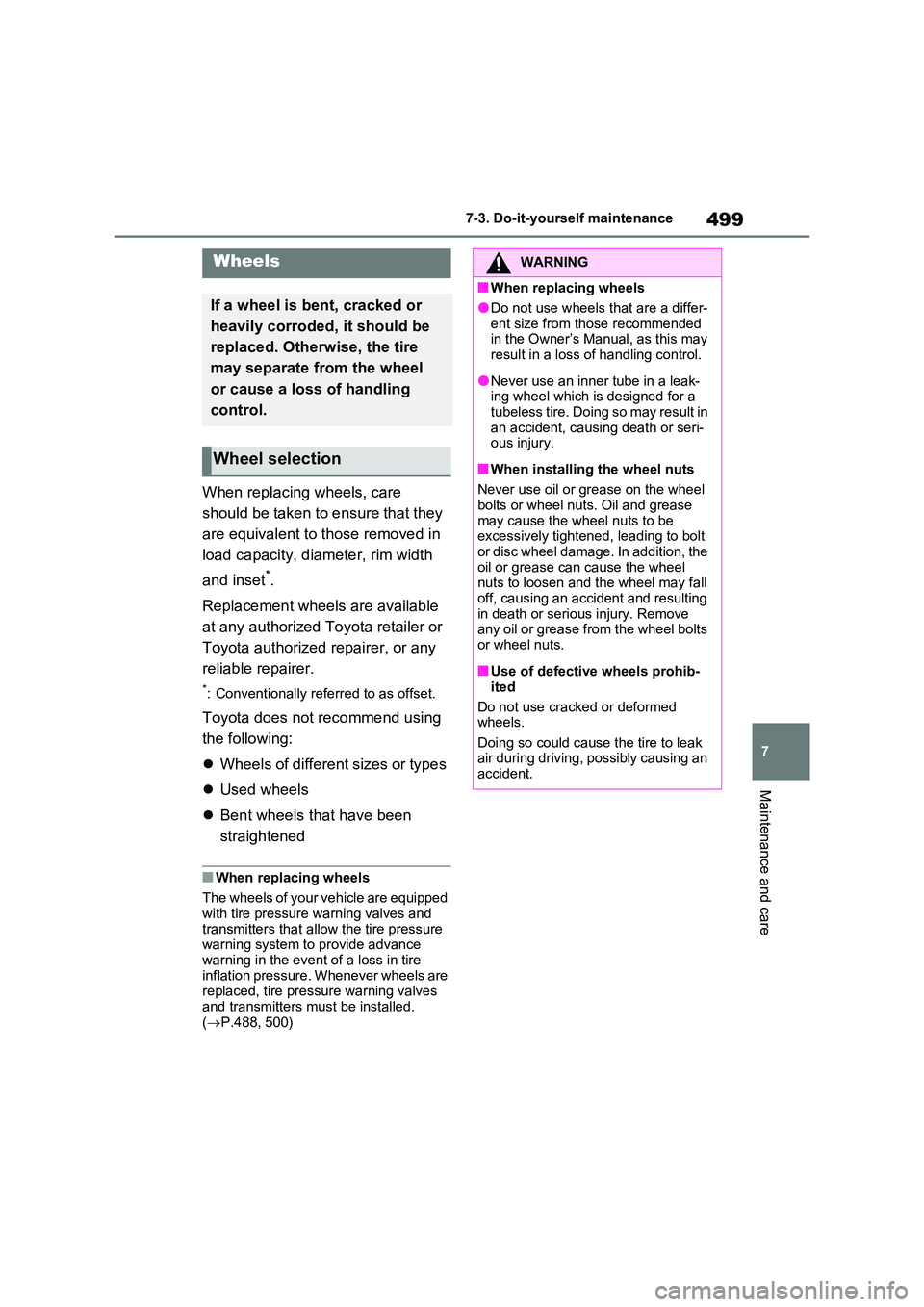
499
7
7-3. Do-it-yourself maintenance
Maintenance and care
When replacing wheels, care
should be taken to ensure that they
are equivalent to those removed in
load capacity, diameter, rim width
and inset*.
Replacement wheels are available
at any authorized Toyota retailer or
Toyota authorized repairer, or any
reliable repairer.
*: Conventionally referred to as offset.
Toyota does not recommend using
the following:
Wheels of different sizes or types
Used wheels
Bent wheels that have been
straightened
■When replacing wheels
The wheels of your vehicle are equipped with tire pressure warning valves and
transmitters that allow the tire pressure warning system to provide advance warning in the event of a loss in tire
inflation pressure. Whenever wheels are replaced, tire pressure warning valves and transmitters must be installed.
( P.488, 500)
Wheels
If a wheel is bent, cracked or
heavily corroded, it should be
replaced. Otherwise, the tire
may separate from the wheel
or cause a loss of handling
control.
Wheel selection
WARNING
■When replacing wheels
●Do not use wheels that are a differ-
ent size from those recommended in the Owner’s Manual, as this may result in a loss of handling control.
●Never use an inner tube in a leak-ing wheel which is designed for a
tubeless tire. Doing so may result in an accident, causing death or seri-ous injury.
■When installing the wheel nuts
Never use oil or grease on the wheel
bolts or wheel nuts. Oil and grease may cause the wheel nuts to be excessively tightened, leading to bolt
or disc wheel damage. In addition, the oil or grease can cause the wheel nuts to loosen and the wheel may fall
off, causing an accident and resulting in death or serious injury. Remove any oil or grease from the wheel bolts
or wheel nuts.
■Use of defective wheels prohib-
ited
Do not use cracked or deformed wheels.
Doing so could cause the tire to leak air during driving, possibly causing an accident.
Page 586 of 718
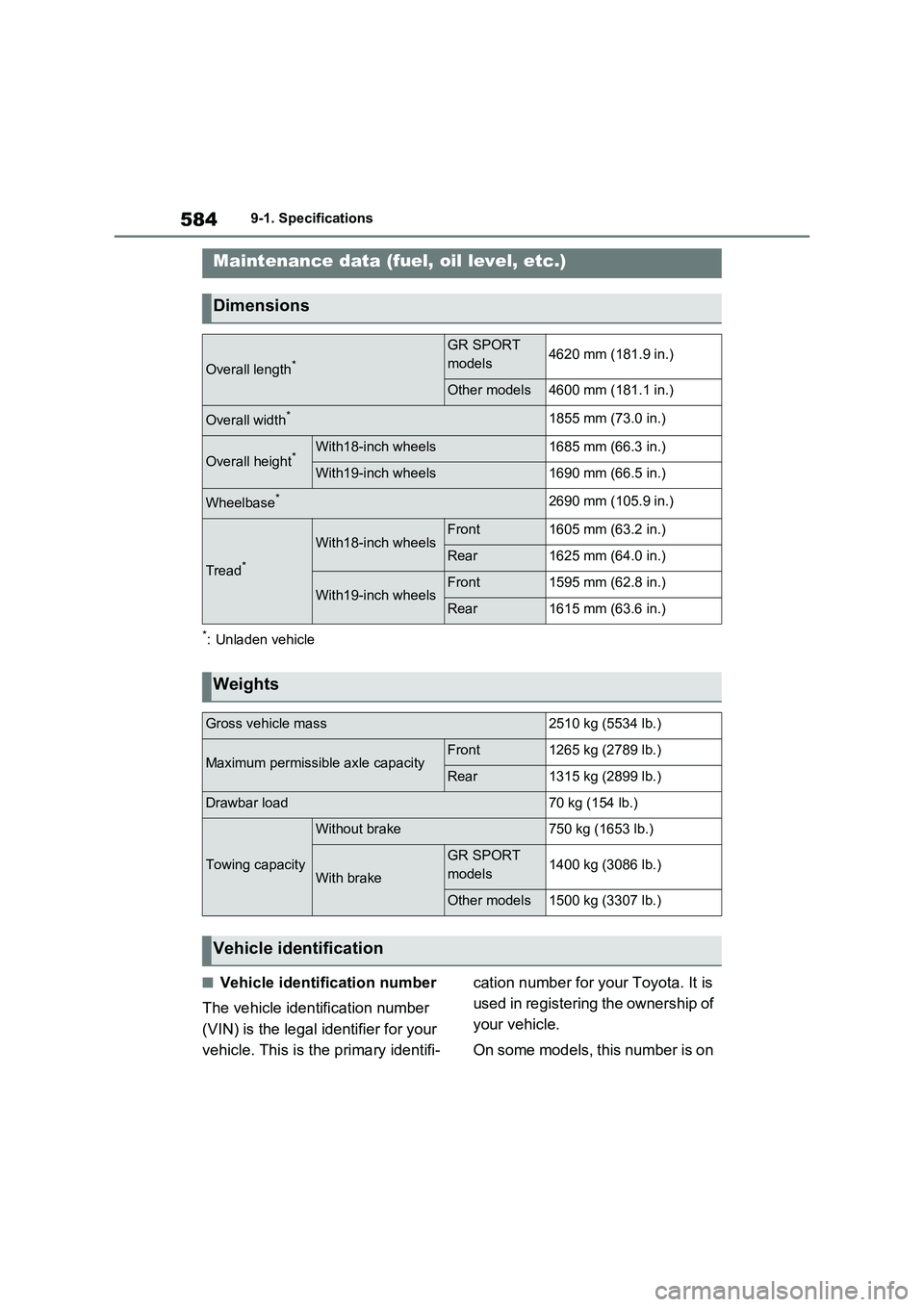
5849-1. Specifications
9-1.Spec ific ations
*: Unladen vehicle
■Vehicle identification number
The vehicle identification number
(VIN) is the legal identifier for your
vehicle. This is the primary identifi-cation number for your Toyota. It is
used in registering the ownership of
your vehicle.
On some models, this number is on
Maintenance data (fuel, oil level, etc.)
Dimensions
Overall length*
GR SPORT
models4620 mm (181.9 in.)
Other models4600 mm (181.1 in.)
Overall width*1855 mm (73.0 in.)
Overall height*With18-inch wheels1685 mm (66.3 in.)
With19-inch wheels1690 mm (66.5 in.)
Wheelbase*2690 mm (105.9 in.)
Tread*
With18-inch wheelsFront1605 mm (63.2 in.)
Rear1625 mm (64.0 in.)
With19-inch wheelsFront1595 mm (62.8 in.)
Rear1615 mm (63.6 in.)
Weights
Gross vehicle mass2510 kg (5534 lb.)
Maximum permissible axle capacityFront1265 kg (2789 lb.)
Rear1315 kg (2899 lb.)
Drawbar load70 kg (154 lb.)
Towing capacity
Without brake750 kg (1653 lb.)
With brake
GR SPORT
models1400 kg (3086 lb.)
Other models1500 kg (3307 lb.)
Vehicle identification
Page 590 of 718
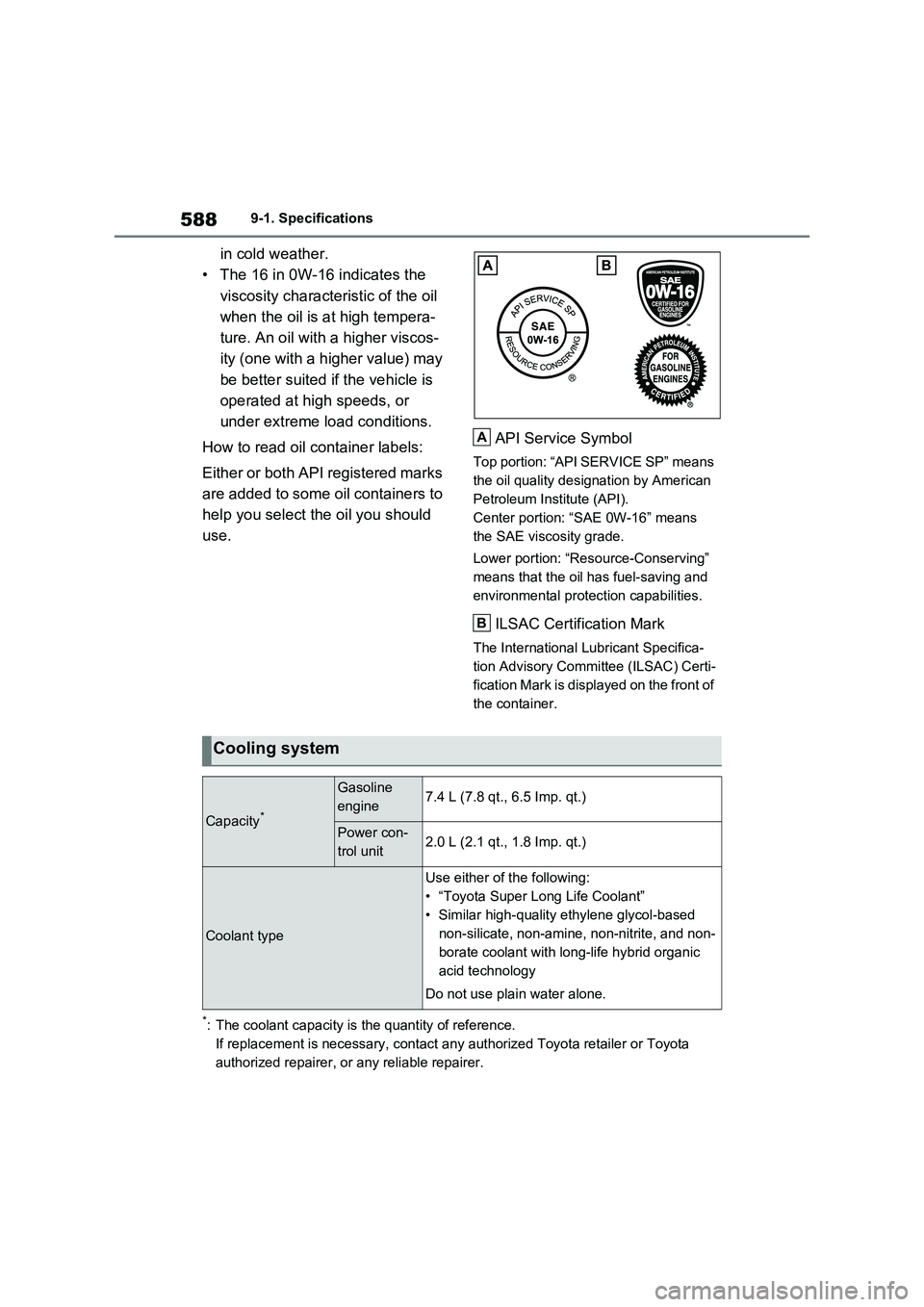
5889-1. Specifications
in cold weather.
• The 16 in 0W-16 indicates the
viscosity characteristic of the oil
when the oil is at high tempera-
ture. An oil with a higher viscos-
ity (one with a higher value) may
be better suited if the vehicle is
operated at high speeds, or
under extreme load conditions.
How to read oil container labels:
Either or both API registered marks
are added to some oil containers to
help you select the oil you should
use.API Service Symbol
Top portion: “API SERVICE SP” means
the oil quality designation by American
Petroleum Institute (API).
Center portion: “SAE 0W-16” means
the SAE viscosity grade.
Lower portion: “Resource-Conserving”
means that the oil has fuel-saving and
environmental protection capabilities.
ILSAC Certification Mark
The International Lubricant Specifica-
tion Advisory Committee (ILSAC) Certi-
fication Mark is displayed on the front of
the container.
*: The coolant capacity is the quantity of reference.
If replacement is necessary, contact any authorized Toyota retailer or Toyota
authorized repairer, or any reliable repairer.
A
B
Cooling system
Capacity*
Gasoline
engine7.4 L (7.8 qt., 6.5 Imp. qt.)
Power con-
trol unit2.0 L (2.1 qt., 1.8 Imp. qt.)
Coolant type
Use either of the following:
• “Toyota Super Long Life Coolant”
• Similar high-quality ethylene glycol-based
non-silicate, non-amine, non-nitrite, and non-
borate coolant with long-life hybrid organic
acid technology
Do not use plain water alone.